Value Design in High Performance Home HVAC w/ Comfort Squad

Neil Comparetto and John Semmelhack of the Comfort Squad join Bryan to discuss high-quality value design in a high-performance home. They explain how they design HVAC systems (heat pumps) for low-load homes in ways that are affordable, efficient, and comfortable.
High-performance, low-load homes need to be energy-efficient AND comfortable, and it can be a challenge to get both. Manual J calculations aren’t as common as they probably should be, and it can be difficult to get accurate data about air leakage, power consumption, and radiant gains as well. So, John and Neil try to collect their own data and do aggressive load calculations to avoid the fudge factors that are all too common. The air velocity inside the ducts tends to be lower in these sorts of systems.
When you have relatively low airflow in the ductwork of high-performance homes, you don’t need as many ducts or for the ductwork to be particularly large. With minimalistic ductwork, supply register placement, face velocity, and throw become very important, especially because those factors are responsible for air mixing. When the duct design conditions are right and the load has been matched, you typically get long runtimes and good air mixing.
In many cases, John and Neil use variable-speed motors in their outdoor units that allow for high heating performance. The capacity ranges are wide, allowing the units to run even during exceptionally low-load conditions. They also use flex ducts due to their pre-insulation, noise suppression, and inexpensiveness; they just try to keep it sealed and avoid compressing the ductwork.
Neil, John, and Bryan also discuss:
- Monitoring load conditions with software
- Design considerations for filter grilles and central returns
- Room pressurization and airflow testing
- Transfer grilles
- The Coanda effect and curved-blade registers
- Vent sizing
- Flex duct installation best practices
- Duct fittings
- ERVs
If you have an iPhone, subscribe to the podcast HERE, and if you have an Android phone, subscribe HERE.
Check out our handy calculators HERE.









Comments
To leave a comment, you need to log in.
Log In